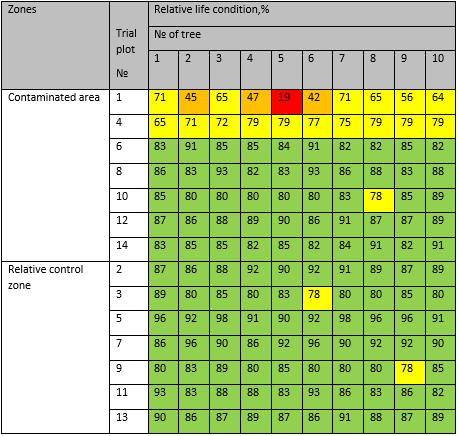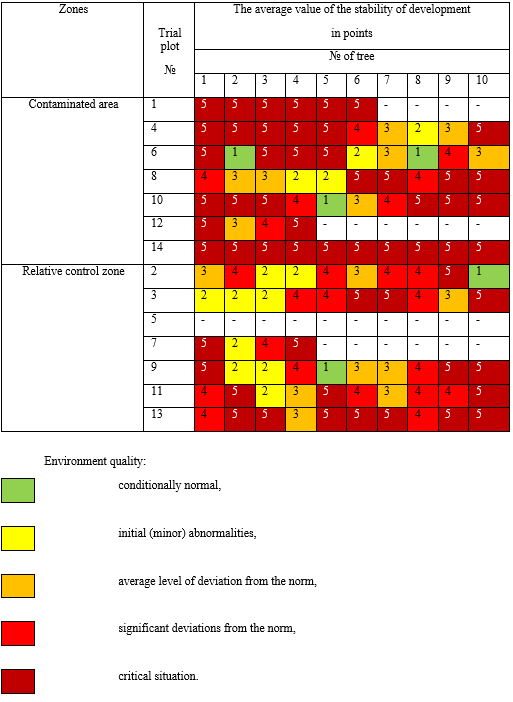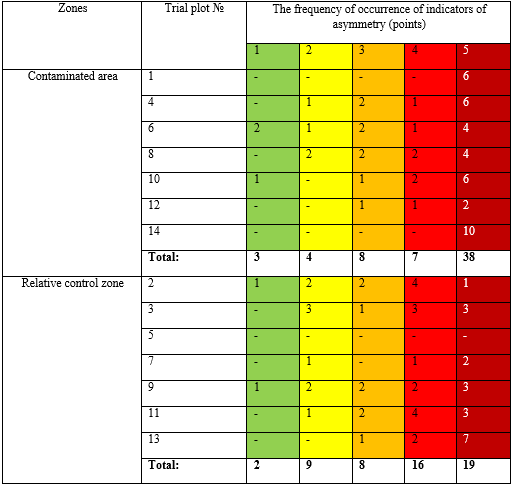Abstract
The issues of assessing the effects of anthropogenic environmental impacts and the response of biota to air pollution, water and soil resources in recent decades have become increasingly important. Modern industrial centers are large cities with an individual history of formation, and the specificity of the current state is conditioned by the complex of natural and climatic conditions and socio-economic situation. Indication of the state of tree plantations is one of the ways to control the quality of the environment and urban conditions. In the Ufa industrial center on the network of permanent sample plots in natural and artificial forest plantations, studies have been carried out to assess the state of the stands. The relative life state of Betula pendula Roth plantations in the industrial zone was estimated as “weakened” (crown density 55–70%; presence of 15–40% dead branches on the trunk; degree of leaf damage 10–40%. Relative control is rated as “healthy.” In the Ufa industrial center with a predominance of hydrocarbon-type environmental pollution, ambiguous reactions of woody plants are observed. This manifests itself in deviations in the development of leaves. Leaves can be used to characterize the condition of birch trees in urban environments, the need to monitor the state of plantations, timely identify violations and changes are associated with the justification of practical measures for the care of plantations and the reconstruction of plantations and reforestation. Timely forestry measures ensure the preservation of the ecological and social functions of forest plantations.
Keywords: Birchindustrial centerindicationlife condition
Introduction
The questions of bioindication of the environment, despite the development of methods for instrumental control of the qualitative composition and degree of pollution by industrial plants, do not lose their relevance (Graham, Raz, Hel-Or, & Nevo, 2010). Adaptive reactions of organisms to the action of extreme factors are noted, providing exceptional resistance of woody plants to industrial pollutants. One of the approaches to assessing the resistance of plants during their growth under extreme conditions is to assess the stability of development and the manifestation of asymmetry (Shestakov, Sagittarius, & Konstantinov, 2004; Zakharov, Baranov, & Borisov, 2000).
Problem Statement
Bioindication of the state of tree plantations is one of the ways to control the quality of the environment and urban conditions.
Research Questions
The subject of the research is the plantings of birch (Betula pendula Roth) of the Ufa Industrial Center, growing in conditions of long-term environmental pollution.
Purpose of the Study
The purpose of the study is to determine the relative life state of the plantations and the morphological changes of the leaves of birch (Betula pendula Roth) under conditions of environmental pollution.
Research Methods
1. Determination of the relative life state of tree stands (Vaganov & Shashkin, 2000). The analysis of the relative life status of plantations was carried out on permanent sample plots in each administrative district of the city of Ufa. Revealed a relatively average living condition of the breed composition.
2. Methods for studying the morphological characteristics used to assess the stability of the development of tree plantations (Shestakov, Sagittarius, & Konstantinov, 2004; Zakharov, Baranov, & Borisov, 2000).
A five-point scale for estimating the deviations of the state of the organism from the conventional norm by the value of the integral indicator of the stability of development is proposed (Kulagin & Shagiyeva, 2005). In this case, the value of the integral asymmetry index of 1 point is interpreted as a conditional norm, which is mainly observed in samples of plants from favorable growing conditions (Kollár & Donoval, 2013). The asymmetry index of 5 points means a critical value, is observed in plants in a highly depressed state, growing in extremely adverse conditions. It should be noted that the focus is on the dependence of the points on the value of the indicator of the stability of development (Graham et al., 2015). The proposed approaches are taken into account and a point scale for assessing the condition of trees and plantations is adopted based on the integral indicator of the stability of the development of birch leaves.
The five-point scale for assessing the deviations of the state of the body from the conventional norm by the value of the integral indicator of developmental stability for birch:
1 point - the quality of the environment is defined as “conditionally normal”;
2 points - quality of the environment as "minor deviations from the norm";
3 points - quality of the environment as “the average level of deviation from the norm”;
4 points - quality of the environment as “significant deviations from the norm”;
5 points - quality of the environment as a “critical state” (Graham, Shimizu, & Emlen, 2003, p. 134).
The source material for assessing the stability of development in accordance with accepted methods was used to measure birch leaves of the right and left halves of the leaf according to 5 signs:
1 sign - the width of the left and right halves of the sheet (when measuring the sheet plate fold in half, combining the top with the base and unbend the sheet, the distance from the border of the central vein to the edge of the sheet is measured along the fold);
2nd sign - the length of the vein of the second order from the base of the leaf;
3rd sign - the distance between the bases of the first and second veins of the second order;
4th sign - the distance between the ends of these veins;
The 5th sign is the angle between the main vein and the second vein from the base of the leaf.
3. Statistical processing of research results was carried out in the programs: STATISTICA 10.0, GraphPad Prism.
Findings
Studies have been conducted to assess the relative vital status and developmental stability (based on the determination of the morphological features of the leaves) of Betula pendula Roth plantations (Vaganov & Shashkin, 2000). These approaches were taken as the basis for research.
Based on the information received (Table
Relative life status of birch TP2 in the territory of Park Pobedy in the Ordzhonikidze district, TP3 in the territory of Kalinin park in the Kalininsky district, TP5 in the territory of them. M. Gafuri Oktyabrsky district, TP6 near the Ufa instrument-making production association of the Oktyabrsky district, TP7 in the territory of the forest park Woodworkers of Bashkiria of Sovetsky District, TP8 near Ufa unitary enterprise “Hydraulics” on the territory of Sovetskiy District, TP9 near the airport of Kirovsky District, TP10 near Pharmstandard - UfaVita on the territory of Kirovsky District, TP11 Zaton park Volna on the territory of Leninsky District, TP12 in Zaton near the Ship Repair and Shipbuilding Plant on the territory of the Leninsky District, TP13 on the territory of the Demsky Culture and Recreation Park of the Demsky District, TP14 the railway station Dema of the Demsky District was rated as “healthy”. The density of the crown is 85-95%. The presence of dead branches on the trunk of 1-15%. The degree of leaf damage by toxicants and insects is 0-10%. The dryness of the trees in these areas is not pronounced (Kulagin & Tagirova, 2015, p. 34).
At the same time, taking into account the relative life status of individual birch trees in the stands indicates a significant difference in the status of individual trees (Figure

The trees of Betula pendula Roth grow on the territory of the Ufa industrial center on 14 trial plots (TP). Collection of leaf samples produced in August 2012.
The integral indicator of the development stability of Betula pendula Roth plantations on the territory of TP1 (table
The integral indicator of the development stability of Betula pendula Roth plantations on the territory of TP2 (table
When combining the data obtained with the relative life state of the birch trees, the coincidence is observed only in one tree (No.10). The stability of tree development is estimated as “conditional norm”, and the relative vital status of this model tree is classified as “healthy”.
The integral indicator of the developmental stability of stands of Betula pendula Roth on the territory of TP3 corresponds to 4 points (asymmetry value is 0.053) and means that significant deviations of the level of developmental stability from the norm occur, despite the fact that the relative vital status of the tree stands under the category of “healthy”.
The integral indicator of the stability of the development of stands of Betula pendula Roth in the territory of TP4 (table
The integral indicator of the stability of the development of plantations Betula pendula Roth in the territory of TP6 (table
The integral indicator of the development stability of Betula pendula Roth plantations in the territory of TP7 (table
The average value of the asymmetry on the scale of development stability in the territory of TP8 corresponds to 4 points (the value of asymmetry is 0.054) and means that significant deviations from the norm occur. At the same time, the relative life state of the plantations is estimated as “healthy”.
The integral indicator of the development stability of Betula pendula Roth plantations on the territory of TP9 (table
The integral indicator of the development stability of Betula pendula Roth plantations in the territory of TP10 (table
The integral indicator of the development stability of Betula pendula Roth plantations on the territory of TP11 (table
The integral indicator of the development stability of Betula pendula Roth plantations on the territory of TP12 (table
The integral indicator of the stability of plantings of Betula pendula Roth in the territory of TP13 (table
The integral indicator of the development stability of Betula pendula Roth plantations on the territory of TP14 (table
On the territory of the Ufa industrial center, in the zone of pollution and in the zone of relative control for plantings Betula pendula Roth, there is no unambiguous connection between the morphological indices of leaf plate asymmetry and the relative life status of the plantings. In some cases, there are significant discrepancies. Deviations in the development of leaves are probably associated with the specifics of the complex effect on plantings of natural, man-made and recreational factors. It should be noted that plantations grow under mixed conditions, with a predominance of hydrocarbon, environmental pollution (Kulagin, 2014).
The average value of the integral indicator of the developmental stability of birch in Ufa corresponds to 5 points (asymmetry value is 0.056) - the critical value of the asymmetry index, which means extremely unfavorable conditions, and the plants must be in a depressed state. On the territory with industrial pollution (table
When considering the condition of birch plantations in different growing conditions, it was found that within one trial area there are significant differences between the trees (the indicator of developmental stability varies from 1 to 5 points; TP 2, 3, 4, 6, 7, 8, 9, 10, 11, 12, 13) (figure
Based on the data presented in Figure


Conclusion
Modern industrial centers are large cities with an individual history of formation, and the specificity of the current state is conditioned by the complex of natural and climatic conditions and socio-economic situation. Assessment of the effects of anthropogenic environmental impacts and the response of biota to air pollution, water and soil resources is an important theoretical and applied task. Instrumental monitoring of environmental quality under conditions of industrial pollution does not provide an integral picture of the state of the environment. In the Ufa industrial center with long-term pollution of the environment on the network of permanent sample plots in natural and artificial forest plantations, studies have been carried out to assess the state of the stands. The relative life state of birch plantations in the industrial zone was estimated as “weakened” (crown density 55–70%; presence of 15–40% dead branches on the trunk; degree of leaf damage 10–40%. relative control is rated as “healthy.” In the Ufa industrial center with a predominance of hydrocarbon-type environmental pollution, ambiguous reactions of woody plants are observed. This manifests itself in deviations in the development of leaves. Leaves can be used to characterize the condition of birch trees in urban areas, the need to monitor the state of plantations, as well as the timely detection of violations and changes in the condition of individual trees is associated with the development of measures for planting and justification for the complete replacement of trees and shrubs and reforestation. Timely forestry measures ensure the preservation of the ecological and social functions of forest plantations as a component of landscape gardening and an object of recreational use.
Acknowledgments
The studies were carried out as part of the work program of the Scientific and Educational Center "Dendroecology and Environmental Management". The studies were carried out according to the state assignment “Adaptation of woody plants and transformation of forest ecosystems of the South Ural region in contrasting natural and anthropogenic conditions” (state registration number AAAA-A18-118022190103-01). The studies were performed using the equipment of the collective center "Agidel".
References
- Graham, J. H., Whitesell, M. J., Fleming, M., Hel-Or, H., Nevo, E., & Raz, Sh. (2015). Fluctuating Asymmetry of Plant Leaves: Batch Processing with LAMINA and Continuous Symmetry Measures. Symmetry, 7, 122-125.
- Graham, J. H., Shimizu, K., & Emlen, J. M. (2003). Growth models and the expected distribution of fluctuating asymmetry. Biological Journal of the Linnean Society, 80, 134-137.
- Graham, J. H., Raz, S., Hel-Or, H., & Nevo, E. (2010). Fluctuating asymmetry: Methods, theory, and applications. Symmetry, 2. 76-79.
- Kollár, J., & Donoval, L. (2013). Diversity of phyllophagous organisms on woody plants in the Botanical garden in Nitra, Slovakia Acta Entomologica Serbica, 18, 124-126.
- Kulagin, A. A. (2014). Monitoring sostoyaniya okruzhayuschej sredy i zdorov'ya gorodskogo okruga gorod Ufa Bashkortostan [Monitor the state of the environment and health of city district city of Ufa Bashkortostan]. Ufa: BGPU.
- Kulagin, A. A., & Shagiyeva, Yu. A. (2005). Drevesnye rasteniya i biologicheskaya konservaciya promyshlennyh zagryaznitelej [Woody plants and biological conservation of industrial pollutants]. Moscow: Nauka.
- Kulagin, A. Yu., & Tagirova, O.V. (2015). Lesnye nasazhdeniya Ufimskogo promyshlennogo centra: sovremennoe sostoyanie v usloviyah antropogennyh vozdejstvij [Forest plantations of the Ufa Industrial Center: current state under conditions of anthropogenic impacts]. Ufa: Gilem, Bashkirskaya entsiklopediya.
- Lesohozyajstvennyj reglament dlya gorodskih lesov, raspolozhennyh v cherte okruga goroda Ufa Respubliki Bashkortostan [Forestry regulations for urban forests located within the Ufa district of the Republic of Bashkortostan]. (2011, June 1). Retrieved from: http://docs.pravo.ru/document/view/18711948/93826677/
- Nikolaevskiy, V. S. (2002). Ekologicheskaya ocenka zagryazneniya sredy i sostoyaniya nazemnyh ekosistem metodami fitoindikacii [Environmental assessment and pollution of terrestrial ecosystems phytoindication methods]. Pushkino: VNIILM.
- Shestakov, G. A., Sagittarius, A. B., & Konstantinov, E. L. (2004). Metodika sbora i obrabotki materiala dlya ocenki stabil'nosti Betula pendula [Methodology for collecting and processing the material to assess the stability of Betula pendula]. Kaluga: KSPU.
- Vaganov, Ye. A., & Shashkin, A. V. (2000). Rol' i struktura godichnyh kolec khvojnyh [The role and structure of coniferous growth rings]. Novosibirsk: Izd-vo SO RAN.
- Van Heezik, Y. M., Freeman, C., Porter, S., & Dickinson, K. J. M. (2014). Native and exotic woody vegetation communities in domestic gardens in relation to social and environmental factors. Ecology and Society, 19(4), 34-37.
- Zakharov, V. M., Baranov, A. S., & Borisov, V. I. (2000). Zdorov'e okruzhayuschej sredy: metody ocenki [Environmental Health: methods of evaluation]. Moscow: Tsentr rossiyskoy ekologicheskoy politiki.
- Zaytsev, G. A., Kulagin, A. Yu., Urazgil'din, R. V., Dubrovina, O. A., Logvinov, K. V., Afanasov, N. A., …, & Amineva, K. Z. (2017). Otnositel'noe zhiznennoe sostoyanie drevesnyh nasazhdenij v usloviyah promyshlennogo zagryazneniya [Relative living condition of tree stands in the conditions of industrial pollution]. Izvestiya Ufimskogo nauchnogo tsentra Rossiyskoy akademii nauk, 2, 45-49.
- Zheng, D., Ducey, M. J., & Heath, L. S. (2013). Assessing net carbon sequestration on urban and community forests of northern New England, USA. Urban Forestry and Urban Greening, 12, 134-137.
Copyright information

This work is licensed under a Creative Commons Attribution-NonCommercial-NoDerivatives 4.0 International License.
About this article
Publication Date
15 November 2020
Article Doi
eBook ISBN
978-1-80296-092-1
Publisher
European Publisher
Volume
93
Print ISBN (optional)
-
Edition Number
1st Edition
Pages
1-1195
Subjects
Teacher, teacher training, teaching skills, teaching techniques, special education, children with special needs, computer-aided learning (CAL)
Cite this article as:
Tagirova, O., Kulagin, A., Zaitcev, G., & Rahmatullina, A. (2020). Status Indication Birch Plantings Of The City As A Environmental Control Method. In I. Murzina (Ed.), Humanistic Practice in Education in a Postmodern Age, vol 93. European Proceedings of Social and Behavioural Sciences (pp. 907-917). European Publisher. https://doi.org/10.15405/epsbs.2020.11.94

